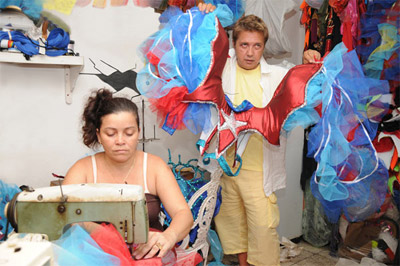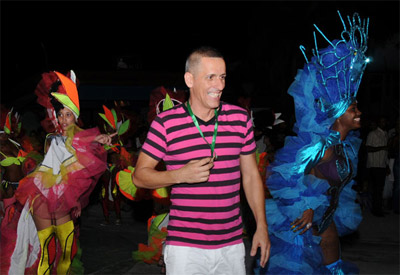Havana Carnival: Behind the Scenes

HAVANA TIMES — This weekend, Carnaval began in Havana – a public event of such importance that it was able to prevail over the severe economic crisis of the 1990s.
It is the collective accumulation of lights, colors, music and sensuality that parades along the Havana seawall to the delight of hundreds of thousands of capital city residents who come out every night of the festival.
We joined the “Guaracheros de Regla,” the largest parading musical group in the carnival, to learn the ins and outs of such a spectacle. Abraham is the costume designer, the person who decides what will be each year’s fashions and colors worn by the “guaracheros,” in accordance with the choreography organized by the group’s director.
Abraham smiles and tells us that now everything is easier because the stores currently sell a wider variety of fabrics and trimmings.
However, he recalled that during the 90’s he had to design costumes for the dancers using “painted military tarps and plastic supermarket bags so that the carnival could continue to exist.”
The Havana carnival might be one of the cheapest in the world. Its artistic director, Efrain Sabas, explained to us. He said that a carnival group like Los Guaracheros costs the Cuban government about 15,000 euros. The director of Los Guaracheros, Hector Medina, explained that “the costumes they wear cost around $100 USD each.”

There’s not enough money to hire makeup artists and hairdressers, so shortly before leaving for the Malecon seawall, the women will make each other up by sharing their own lipstick, mascara and eye shadow. They’ve waited a year to experience their moment of glory so they all want to look especially beautiful and sensual.
Los Guaracheros are residents of the Regla community of Havana, a neighborhood located across the Havana Bay and that likes to call itself a “town.” The troupe was born in 1959; six months after Fidel Castro took over the capital leading his bearded guerrillas. Since that time the group has won the carnival prize five times, and some people assure that on many occasions they lost unfairly.
Participation is voluntary, and no one earns a dime, but for all of the residents of Regla it’s an honor to dance in Los Guaracheros. The oldest dancer is 40-year-old Yamila Garcia, who is an assistant prosecutor by profession; however she assured us that she doesn’t have any problems with her work; as carnival approaches and the numbers of rehearsals increase, she’s even given time off with pay to practice.
The troupe rehearses four times a week throughout the entire year, making it necessary for the members to spend most of their free time practicing in it. The choreography is complicated, requiring perfect timing and excellent physical condition, taking into account that during their route along the Havana seawall they will have to dance for three hours straight before the expectant eyes of their fellow Cubans.

Medina explained that the prestige of Los Guaracheros de Regla is such that sometimes participation is encouraged from generation to generation. Presently there are some women who dance for the troupe whose mothers and grandmothers were also dancers who enjoyed carnival in past decades. Several told us that they don’t even want to think about the time when they’ll have to leave the troupe.
This year nature played a cruel trick on them. On Friday, at the moment they were to begin the first night of carnival, a torrential downpour started that soaked the dancers, the floats and the crowd in attendance. We saw the members of the different groups soaked and shivering, but what saddened them most was not being able to dance.
After wringing out their costumes and drying off their equipment, on Sunday night they made their long awaited debut before hundreds of thousands of people who can certify that carnival is still the most popular festival in Cuba.

The shortcomings of Havana’s Carnival go far beyond the material factor, and these began long before anyone even suspected that one day the Special Period crisis would hit. Poor decisions and prohibitions are what killed the soul of the fiesta, from changing its date from January-February to July, to preventing the public from parading freely, or when — citing the need to maintain public order — they began preventing people from wearing the costumes of their choice. All these traditions had prevailed for decades among Havana residents.
A special interest used to be stirred by the annual election of the carnival queen and her entourage of beauties; so with the ending of that tradition we saw the event cut off at the root.
Gradually, little by little, the face of the most authentic popular demonstration that the capital ever had was becoming disfigured.
What today parades down the Malecon is a monstrosity, just a dull and rundown memory of what I witnessed and experienced in my childhood.